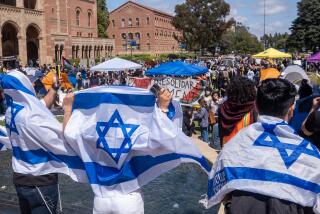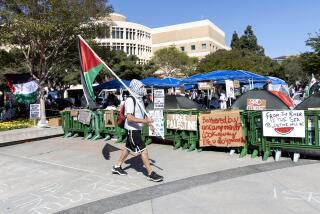COMMENTARY : Student Activism Is Back in Vogue, but Not Like in the ‘60s
- Share via
A funny thing happened on the way to the ‘90s--”student activism” lost its status as an oxymoron.
Since around 1987, campus protests have grown bigger, more frequent and better organized than in years past. At UC Irvine, a campus known better for its apathy than activism, protests and rallies drawing hundreds of students are no longer the rarity they once were. And in recent months, smaller protests have become almost routine.
As protests have become more frequent, protesters have grown more tenacious. They are more inclined to get themselves arrested for acts of civil disobedience than before and to endure physical hardship during round-the-clock vigils, protests at remote locations and inclement weather.
For these reasons, some people contend the ‘60s have returned to college campuses for an encore of student political involvement. They cite the recent surge in high-profile activism as evidence that the pendulum finally has swung back.
However, that’s probably reading too much into recent events. Student activists are still a small minority on most campuses, and even with their considerable vigor, there is no evidence that their ranks have swelled. The real change is that they are pursuing their goals with much greater sophistication.
They have formed stable, efficient groups with clearly defined objectives and methods. Because these groups often support several causes and maintain a loose affiliation with other activist organizations of a similar political bent, they can produce consistently sizable demonstrations even without energetic support from the majority of students.
Few details are now overlooked in planning protests. How signs should be phrased and precisely what will be said to the media are decided beforehand to ensure the group appears unified in purpose. These procedures, coupled with the desire for advance publicity to guarantee a large turnout, all but preclude spontaneity at many student protests.
In several recent cases, protest leaders have gone to the point of conferring with the police on the time and place acts of civil disobedience will take place and the number of protesters who wish to be arrested.
For their part, the police, who wish to appear reasonable and avert potential violence, are often cooperative to the point of appearing as willing participants. One recent protest at UCI appeared almost scripted. Having discussed the arrest procedure with the activists beforehand, police allowed protesters to block the entrance of a building for 10 minutes before giving the first verbal warning. After the first 10-minute delay, police read a statement warning students that arrests would be made in 10 minutes if they didn’t disperse.
If ‘60s-style activism has returned to college campuses, it’s back with an ‘80s-style self-consciousness--and an acute awareness of the media’s role in shaping public opinion.
Recently, during a protest at a Nevada nuclear test site, activists purposely scheduled their action hoping to make it convenient for a Los Angeles Times reporter working on deadline to get their protest into the next day’s edition. Soon after, a last-minute proposal to move the protest to another site prompted the group to ask reporters whether that would interfere with their ability to cover the demonstration. Reporters refused to aid in the planning of the action, and protesters decided not to gamble on changing locations.
While some activists pride themselves on creating considerable public awareness of their causes, others remain ambivalent and question whether the methods cheapen the message. A few students have suggested that their demonstrations may be in danger of becoming “McProtests”--triumphs of slick packaging with scant substance.
For all that, though, demonstrations do seem to be contagious. Students who do not generally identify themselves as activists are now more likely to organize one-time protests to publicize their gripes. But these are geared more often toward venting frustration over crowded classrooms or dormitories, for example, than effecting political or social change.
Longtime student activists are probably indirectly responsible for the increased number of one-shot protests by fostering an environment in which demonstrations are considered a conventional method of addressing problems. Ironically, because of this, some previously inactive students who chafed in silence at the demands made by activists have begun to stage counter-protests of their own.
As the ‘90s begin, the number of activists is sure to grow, but whether they ever become a majority or even a sizable percentage of the student population is doubtful. However, their impact will continue to be felt as long as demonstrations call attention to issues many students would otherwise ignore.
And although the ‘90s may earn a deserved reputation for its own brand of student activism, the ‘60s won’t be back this way for a while.
More to Read
Sign up for Essential California
The most important California stories and recommendations in your inbox every morning.
You may occasionally receive promotional content from the Los Angeles Times.










